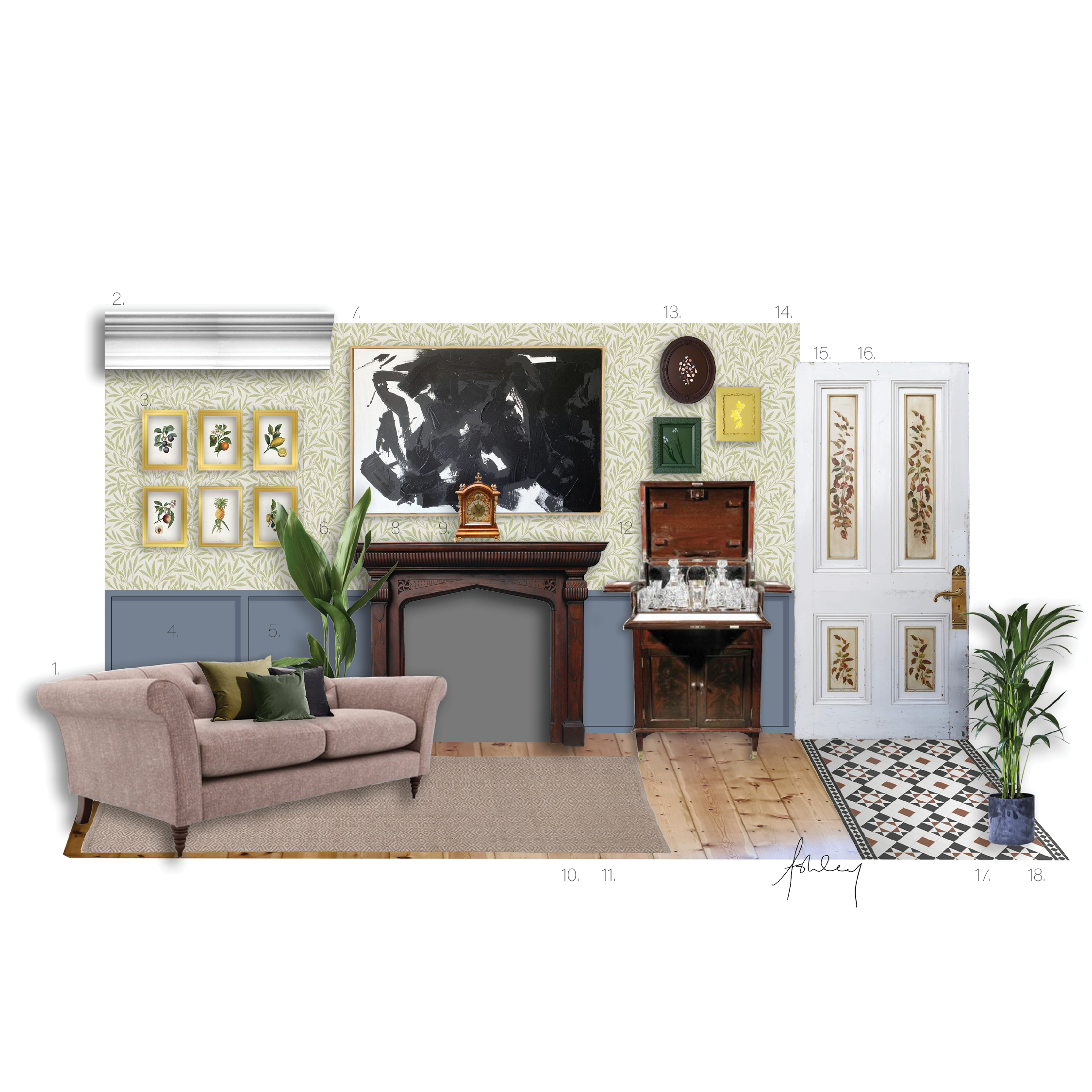Interior Design Palettes through the ages - Victorian
The Victorian era, aligning with the reign of its namesake Queen Victoria, spans a period of 64 years from 1837 to 1901. As with any other period it is impossible to define one singular style, and with the industrial revolution and commercialisation people had the option to combine many. Before studying Conservation of Historic Buildings at the University of York, my knowledge of historic Victorian interiors was limited to visions of a Dickensian dusty room, stuffed full of curiosities/trinkets/tchotchkes, with a fabric and cobweb draped Miss Havisham, on the edge of bursting into flame! However, Victorian design and style was far less dour and dark than often assumed. It was all about accessibility, freedom of expression, and often a mixture or reinterpretation of multiple styles.
Alt Text: Watercolour illustration of Cheniston Lodge (c.1885), Cheniston Gardens, London. Illustration by Ashley Thomas-Pate.
Moving away from classical influence, Victorians were inspired by the Gothic and the Medieval (think macabre or mysterious, horror, gloom, the sublime!). Trends and movements that appeared and evolved during the Victorian era include the Gothic Revival, Queen Anne Revival, Art Nouveau, Arts & Crafts Movement, and the Edwardian period.
Mass production of furniture and interior decoration was brought on by industrialisation which meant more affordable prices. Decorating your interior was no longer just for the elite, but within reach of the middle and lower classes as well. Bare walls were seen as a reflection of lack of wealth and taste.
During the Victorian period we also begin to see the beginnings of the Conservation movement, caring for the historic environment. John Ruskin wrote The Seven Lamps of Architecture in 1849 in which he promoted Gothic as the ‘truest’ style of architecture. Inspired by Ruskin, William Morris (known for his romantic, naturalistic wallpapers) was inspired to focus on artisans, hand-crafted arts and architecture, and the rejection of industry manufactured objects. He later founded the Society for the Protection of Ancient Buildings (SPAB) in 1877 to protect ancient buildings from “restoration” to an idealised state from the past, and instead promoting care and custodianship to conserve and repair buildings as they stand.
As mentioned above, the Victorian era included a multitude of styles, but here are a few things to look out for:
Rich dark colours such as red, forest greens and dark blues (wall colours often needed to be dark to hide soot and smoke from gas lamps, fireplaces and smoking), bold patterns, ornate fireplaces, stained glass, mass produced printed tiles (think Burmantofts in Leeds or encaustic floor tiles), wallpaper.
The following mood board is inspired by the Victorian era, and aims to use as many sustainable and vegan finishes & furniture as possible.
Alt Text: Victorian-inspired interior design palette, including as many reclaimed, sustainable, and vegan options as possible. Design by Ashley Thomas-Pate.
1. cedar sofa by DFS vegan collection, 2. moulding, 3. botanical prints by Vintage Print Collection for Juniqe, 4. painted panelling in Navy Blue by Edward Bulmer, 5. sanela velvet cushion covers by IKEA, 6. aspidistra plant (this one from Patch Plants), 7. ‘untitled 01’ by Sarah Walsh, 8. reclaimed fireplace (UK Architectural Heritage), 9. vintage mantel clock (this one from Antique Clocks), 10. dormouse diamond rug by Weaver Green, 11. pine plank flooring, 12. vintage Edwardian drinks cabinet, 13. artwork by Carolyn Misterek, 14. William Morris wallpaper Willow Bough in Olive, 15. reclaimed Victorian door (UK Architectural Heritage), 16. reclaimed c.1900 lever hardware (ebay), 17. osterley terracotta tile (Topps Tiles), 18. kentia palm plant (this one from Patch Plants)
Sources:
Courses taken while studying at University of Oregon for my Bachelor of Interior Architecture (History of Interior Design, History of Western Architecture) and at University of York for my Masters of Arts in Conservation of Historic Buildings (Analyzing Historic Buildings and Interpreting Historic Buildings)
Edwardian House Style Handbook, by Hilary Hockman, 2007
The History of English Interiors, by Alan and Ann Gore, 1991
Period Details, by Judith and Martin Miller, 1993
https://www.nationaltrust.org.uk/discover/history/architecture/interior-design-through-the-ages
https://victoriansociety.org.uk/site
https://v2.wellcertified.com/en/wellv2/mind/feature/2
https://www.usgbc.org/leed/v41
https://www.rhs.org.uk/plants/types/houseplants/for-human-health

